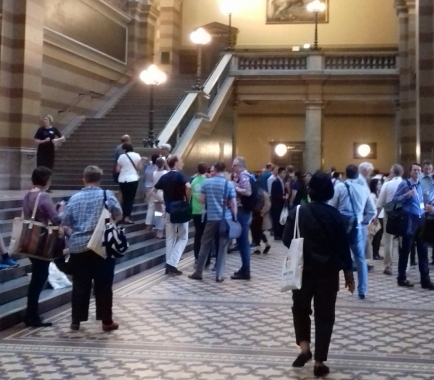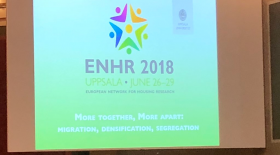More Together, More Apart: migration, densification, segregation
Report from the annual conference of the European Network for Housing Research
Uppsala, 4 July 2018 | Published in Research
The theme of this year's European Network for Housing Research (ENHR) annual conference was “More Together, More Apart: migration, densification, segregation”, and over 400 economists, sociologists, legal scholars, architects, urban planners, academics, researchers and housing experts came together in the town of Uppsala, Sweden, to grapple with such questions as: “what is the role of research?”, “how can we plan and build inclusive spaces?”, “when did human beings start using passports?” Mariel Whelan attended the conference on behalf of Housing Europe, presented our latest briefing on migration and reports.
Attendees of the keynote and plenary sessions were given an insight into the current Swedish housing situation: traditionally, Sweden has taken a universal approach towards housing – meaning that there is no means-testing, everyone is entitled to social housing and, generally speaking, this has been a politically neutral tenure.
It is in this context that Roger Andersson notes that recent moves of spatially selective interventions are unusual. The socio-economic and ethnic segregation manifesting in large housing blocks built from the '50s to '80s, has become the symbolic and public image of societal segregation. Indeed in January of this year, the Swedish government launched a dedicated “Delegation against Segregation”.
Andersson argues that it is not the scale, nor the design or location of housing estates that lead to socio-spatial segregation of marginalised and migrant groups, but rather market dynamics, structural causes, policy changes and the shifting role of tenure. Bengtsson goes further and says that the Swedish housing regime is in crisis, and is becoming marketised and selective - “a monstrous hybrid”.
Uppsala City Council presented their Östra Sala Backe 2030 development plan, in which two neighbourhoods of different socio-economic compositions are physically brought together via the development of residential and commercial property in the long stretch of unused land between the two areas.
Other major discussions centred on the global and European flows of migration, comparative analyses of asylum, housing and inclusion policies and practices, housing choices for newcomers, the role of public space for civic discourse and community engagement, deliberative democracy, the interconnectedness of access to housing with access to education, healthcare and labour opportunities.
There was no lack of provocation – Ingrid Gould Ellen from NYU suggests that gentrification of cities and urban areas might not necessarily be a negative. To start with, we cannot seem to agree what it means, we are unsure as to its consequences, the only thing that is certain is that the term elicits controversy and anxiety.
With regards to densification, is it a panacea for creating sustainable communities that save on energy, land and water, as certain architects, planners and political representatives would have it? Michael Neuman says, “No – we should avoid densification, and focus on design instead”. Per G. Berg elaborates on this sharing research showing that overly dense urban blocks generate more consumption of physical resources, are more expensive, restrict cultural expression and threaten healthy habits.
Another novel thought that was highlighted over the course of the conference is that – minority groups within a society need their enclaves. Specifically, spaces in which the majority or dominant group is not allowed to enter, and where minority groups (and marginalised groups more generally) can comfortably and honestly support and share with each other, and so in this sense, a certain form of segregation is not only positive but necessary.
Working groups, of which there are 27, broke out into sessions where research topics such as activist co-housing in Barcelona, do-it-yourself senior co-housing, demographic change and the future of social housing in England, the international perspective of rent stabilisation and rent control, gated communities as an ambiguous defence and transitional spaces as a level for social sustainability in dense housing projects were presented and discussed.
The recently-formed working group Refugees and Housing, of which Housing Europe is a member, hosted presentations on topics varying from studying the perceptions and attitudes towards newcomers, that perceptions do not align with realities, how these can be shifted and are shifting, to global practices of emergency accommodation and shelter of displaced people, to local housing markets' ability to appropriately house newcomers, as well as local authorities' experience of welcoming, housing and supporting asylum-seekers and refugees.
We learned that: tents in refugee camps are expensive, costing around $7-8,000 and with an average length of stay of 12 years.
Read MoreCertain countries offer a voucher system in which people who have been displaced can purchase a site and building materials, or an already built dwelling. One area of concern is the private rental market, which needs to be regulated in order to combat exploitation.
Following on from the “refugee crisis” or “Mediterranean crisis” of 2015, Norwegian municipalities were able to “intensify efforts” to locate accommodation for newcomers, whereas previously they had said this was not possible and that there was no accommodation available. Since then, 2 of 3 municipalities will continue to accept refugees. The policy in Norway is that the national government will request a municipality to take in X amount of refugees, and the municipality can then respond in the affirmative or negative, or suggest another number of people that they would be willing to receive.
In Lebanon, refugees make up 23% of the population, there is currently a “no camp policy” which also translates into a “no housing policy”. International humanitarian organisations are unable to enter the country, refugees are not entitled to work, and polarisation on the issue of migrants exists in Lebanon.
In Syria, conflicting claims to the land are creating an opaque legal situation in which the government is using subtle institutional methods to seize areas won from ISIS. Foreign entities are investing in the development of high-end, luxury properties, such as Marotah City. Simply put, the Syrian people were first displaced by war, and are now being displaced by land grabbing.
In Germany, we learned that local populations are more concerned with “cultural change” than economic change and the contact hypothesis still holds true – that interpersonal contact, interaction and exchange between minority and majority groups is one of the most effective ways to reduce prejudice and increase understanding.
The concept of home is a complex and nebulous one, especially for those who have fled their “HOME” as a result war, conflict, extreme poverty, climate change, famine, land grabbing, who find themselves in an inadequate, temporary, emergency “home” for an undetermined period of time, who are wondering what their more permanent, future “Home” might look like and when they might move into it. Questions remain: can reception facilities exist as home-like spaces? More importantly, should they? How are home-making actions and accommodation in general shaped by the external structure of opportunities?
While the European political and legal landscape continues to fluctuate and adapt in response to trends of housing exclusion, shortages and crises, within the context of increased urbanisation, demographic change and populist nationalism, housing researchers and practitioners continue to gain and use knowledge from the social sciences along with data, research and best practices from the ground, to advance and promote housing policies and practices that will provide for decent and affordable housing in environmentally, socially and economically sustainable communities.

